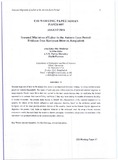Seasonal migration of labor in the autumn lean period: Evidence from Kurigram district, Bangladesh
Abstract
Seasonal migration of labor in the autumn lean period is an important livelihood strategy for a large number of poor people in Northern Bangladesh. The nature of such migration differs from that of permanent internal migration in many respects. People move for a short time period in the lean season because they are confronted by limited opportunities to maintain their current living conditions if they stay home during the months of economic hardship in October-November. The present study intends to identify the characteristics of the seasonal migrants and to quantify the effects of the factors influencing such migration decision, based on the evidences gained from Kurigram, one of the most poverty-stricken districts of the country. Based on the Hunian Capital Approach to Migration, the present study looks at migration behavior at the individual level. By using a binary response econometric model, the study finds that economic factors, ecological vulnerability and personal characteristics of the individuals have profound effects on the seasonal migration decision.

